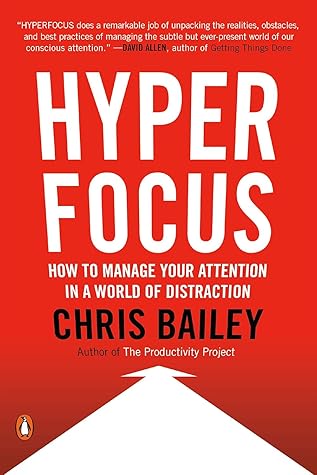More on this book
Community
Kindle Notes & Highlights
by
Chris Bailey
Read between
December 7, 2024 - January 12, 2025
7. Get things to bid for your attention.
8. In the moment, zoom out.
9. Invest in serendipity.
10. Double down on what’s valuable.
The brain needs a few minutes to switch between hyperfocus and scatterfocus. Therefore, taking scatterfocus breaks that are at least fifteen minutes long will yield better results than trying to take advantage of tiny chunks of time throughout the day. But even brief breaks will help you become more creative, for while they may not leave sufficient time to piece together complex eureka insights, they’ll definitely enable you to set intentions for what to do next, rest, and capture the open loops at the top of your mind.
In many ways hyperfocus and scatterfocus are complete opposites. At any given moment, we’re either doing something (with external attention) or thinking about something (with internal attention). We’re unable to be in both hyperfocus mode and scatterfocus mode at the same time.
To put it bluntly, positive thinking does not work to make you more happy or productive. In fact, research has shown it’s counterproductive.
Positive thinking lets us feel successful in the moment, but at the price of making an actual plan to become successful later. In practice, there’s little difference between positive thinking and wishful thinking.
Generally speaking, a wandering mind makes us less happy, unless we’re thinking about something we’re interested in, something useful, or something novel. Scatterfocus—the intentional form of mind wandering—lets us experience all three. Why, exactly, does investing in happiness foster productivity and creativity? First, and most important, a positive mood expands the size of your attentional space, regardless of which mode you’re in.
On the other hand, a negative mood shrinks the size of your attentional space.
People who are unhappy also take longer to refocus after an interruption and dwell more often on their failures.
You’re the most productive when you dedicate your energy-rich moments to your most complex, meaningful tasks.
Hyperfocus is most effective during your peak energy times—I call these your Biological Prime Time (BPT), and the precise times of day differ for everyone. (By charting your energy levels for a week or two, you’ll be able to identify your own patterns.) The more productive tasks you do during your BPT, the more productive you become.
Scatterfocus is most powerful when you have the least energy. Your brain is less inhibited during these periods and doesn’t hold back the ideas it generates.
One study discovered we solve 27.3 percent more insight problems during our nonoptimal time of day, when we’re naturally more tired.
I call these time periods when we have the least energy our Creative Prime Time.
There’s no shortage of research examining when we naturally have the most energy. For most people this occurs during the late morning (around 11:00 a.m.) and midafternoon (around 2:00 or 3:00 p.m...
This highlight has been truncated due to consecutive passage length restrictions.
When doing the same for your own schedule, ask yourself questions like these: How much productivity and creativity will I need this week? Does an upcoming deadline mean I need to hyperfocus more than usual? Or do I have more space to plan for the future and connect ideas? What commitments do I have coming up that will get in the way of my hyperfocus and scatterfocus time (e.g., travel, a draining conference, or an inordinate number of meetings)? How can I deal with these obstacles in advance? How many blocks of time can I commit to hyperfocus and scatterfocus? Can I commit to these periods in
...more


